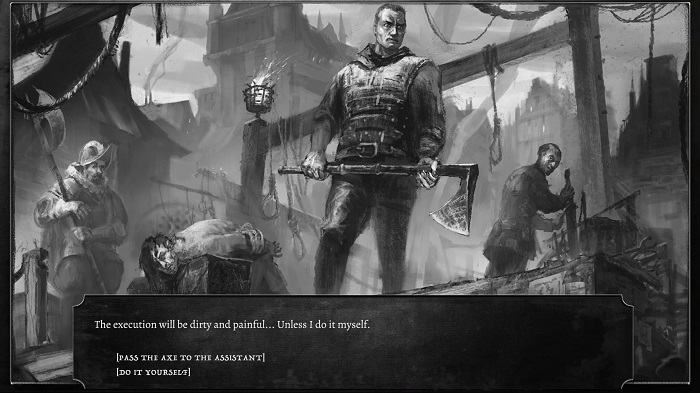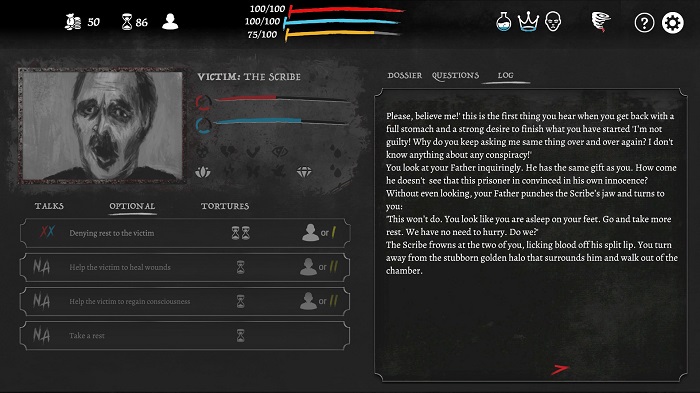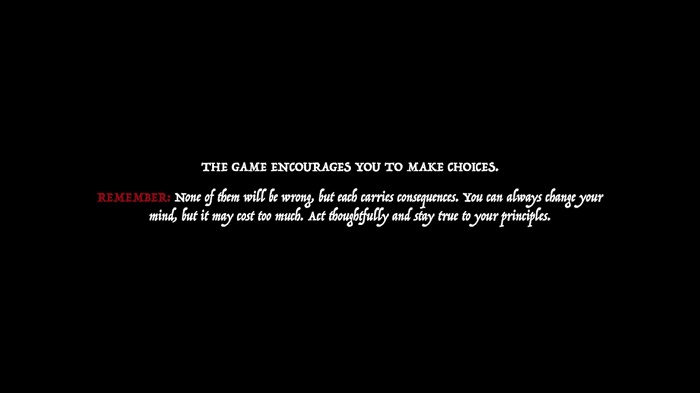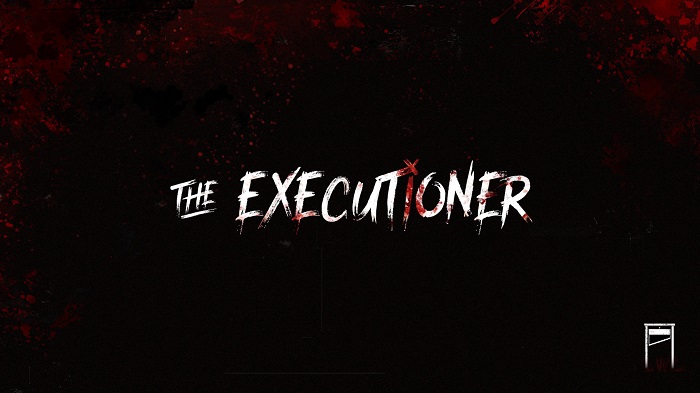Subjective:
Developer and publisher Lesser Evil Games present The Executioner for review. The Executioner uses text-based adventure gaming to put the player in the titular role of an executioner. Backed by ominous graphics, musical score, and limited voice acting, the developers aim to create a space of mental anguish where each choice weighs heavily on the future.
Objective:
The Executioner is not a pleasant experience. The many illustrations that accompany the text descriptions have an ashen and half-seen quality. The humanity of your victims is never clear, and even when they’re antagonists placed directly in your way the ashen outlines sharpen into a more angled threatening obstacle. There’s sparse voice acting but it is dour and menacing when present. The same goes for the constantly running music that adds to the air of oppression. There are also sanity and health checks that require balancing your actions and finding ways to refresh yourself from the continuing horror. As time wore on it became more rare to find a description that didn’t have a glaring grammar problem. I’m not referring to a misplaced comma or apostrophe, but code appearing in the body of the text or several misspelled words in the same paragraph. This isn’t disastrous to the tone, but hurts the moment-to-moment experience.

Assessment:
The Executioner is the next natural step for what I call oppression sims. You could run dictatorships in Tropico, determine who gets across a border in Papers, Please, and maintain your own oppressive venture in Prison Architect. They reflect the opposite mindset of time loop games such as Outer Wilds or The Sexy Brutale. Gameplay loops in those sorts of titles give us the opportunity to make things right. In contrast, oppression sims have the goal of using whatever means necessary to make sure the virtual populace is too cowed for things to go wrong to begin with.
If The Executioner were pleasant or aimed for humor it wouldn’t work. But its aesthetic is so thoroughly unpleasant that I wanted to keep playing more for what I could inspire within the ugliness than any enjoyment the systems could bring. The many portraits of the presumably guilty become ghoulish caricatures of already scared people as they arrive to the executioner’s den. I wish Lesser Evil Games stuck to their guns and didn’t show portraits of the victims healing in-between sessions, but the faint return of humanity is enough to remind the player of what they’re wrenching out of these poor people.

Oppression is the explicit goal via torture, dismemberment, or humanity. It’s the last bit that really stings when you give the victims a moment to breathe just so you can get back to doing your job. The humanity also allows for disturbing connections outside the executioner’s den with the daughter of one victim a potential ally in this den of despair. The many text descriptions paint a vivid portrait of people doing what they’re told all while looking for where they can stick the knife into someone else for relief. Your choices actually matter here, and the person you beat for information may be the one who could get you out of a jam later on.
I like that The Executioner does not necessarily equate revolution with being a good person, and that work within the system can give you the tools to dismantle it. Where it falters, however, is in execution and expectation. For execution, the misspellings and code interruptions become so common that it’s clear this could have used more time polishing up the script and debugging the pop-ups. The other disappointment is in thinking The Executioner was a self-contained product. As I finished the game the text informed me that The Executioner is one of a planned three chapters, and it takes the wind out of wanting to see the continuation of the path I’d chosen when the consequences were already intriguing.

The Review
The Executioner
A bit more spit-shine would have done The Executioner a world of good. Lesser Evil Games does such great work creating this nightmare of oppression but loses it right when things are at their most atmospheric. I'm also grumpy that this couldn't be a finished product, but it's at least enthralling enough to ensure I'll be back for the next chapter to see how my executioner's story continues and if the whispers of revolution can grow into something that breaks the gloom.
PROS
- Art style that switches from ashen to angular without losing any of the disturbing dehumanization that's going through the executioner's head.
- Choices do actually matter, and allies in one play through may just as easily be opponents or indifferent watchers in the next.
CONS
- An incomplete product, both in being one of a planned three chapters and featuring a mountain of text problems.



